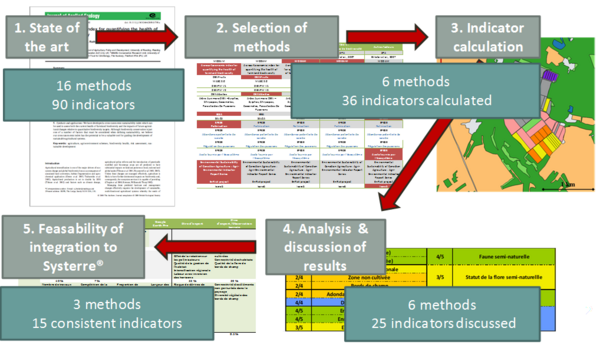Part of the DiverIMPACTS project aims to develop an indicator framework, which is suitable to evaluate the sustainability of diversified cropping systems. Among the sustainability issues, the impact that farmers’ management has on biodiversity is of great concern. A recent master’s thesis, supervised by DiverIMPACTS partners, compared biodiversity indicators that were tested in a farm system experiment at an Arvalis (Institut du Végétal) experimental station in Boigneville, France.
The objective of the study was to identify predictive biodiversity indicators that could be integrated into the multi-criteria assessment tool and indicator calculator, Systerre®. This tool was selected to support the calculation of the results for the indicators developed for the DiverIMPACTS case studies. In order to determine which indicators are most suitable, it is important to characterize their strengths and weaknesses, especially the relevance of their outputs. This can be performed by comparing their output with those of other indicators. In this study, we compared the results of a set of predictive and causal indicators, which were calculated with data from the system experiment. Predictive indicators (e.g., biodiversity indicator from the multi-criteria assessment tool DEXiPM assessing the sustainability of cropping systems), based on outputs from simplified or more elaborated models, are a useful alternative to simple causal indicators (e.g., nitrogen rate) or effect-measured indicators (e.g., carabids diversity) for the design of innovative cropping systems as carried out in DiverIMPACTS.
Figure 1 summarizes the methodology. The literature review and author expertise led to the selection of six relevant causal indicators (e.g., nitrogen rate) and four qualitative models using the DEXi tools, including two versions of the DEXIPM biodiversity indicator. Data from the system experiment were used to calculate the results for each indicator over 3 years (2009-2011) from four cropping systems: an optimized conventional (CONV), an integrated (INT), an intensive non-tilled (MACH) and an organic (ORG) system.
The calculation of causal indicators confirmed the intensity gradient: ORG<INT<CONV<MACH. In two of the DEXiPM models, the agreement between results for the global biodiversity and component calculations (e.g., flying natural enemies) was in general good, and the ranking of the systems confirmed the intensity gradient. An exception is the weed sub-indicator, for which the calculation method has to be modified in order to enhance its predictive quality. The integration of the DEXiPM model in the Systerre® tool would require limited effort if some supplementary data (e.g., on the surrounding landscape) are provided by experts. The ability of the DEXiPM indicators to trace cause-effect relationships should also be transferred to Systerre®.
Authors
Christian Bockstaller, French National Institute for Agricultural Research (INRA), France
Thomas Denoirjean, ARVALIS - Institut du végétal, France
Véronique Tosser, ARVALIS - Institut du végétal, France
Frédérique Angevin, INRA, Eco-Innov, France

 tap and then scroll down to the Add to Home Screen command.
tap and then scroll down to the Add to Home Screen command.